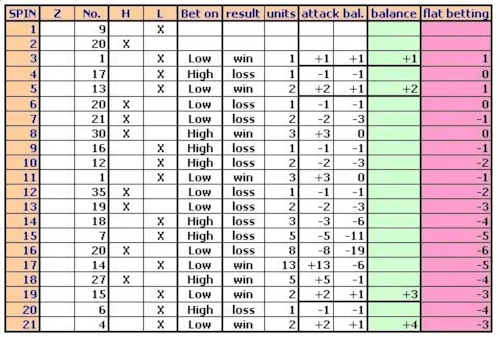 September 15 2024
September 15 2024
Roulette is one of the most popular casino games worldwide, and the amount of online roulette sites just keep growing, so it must mean there are more than enough players out there.
Today we’re going to talk about roulette strategies. In reality, there are mathematically grounded betting systems that players use to manage risk and potentially increase their chances of short-term success.
However, none of these strategies can fully eliminate the house edge. In this article, we'll examine the most commonly used roulette strategies, explaining them through the lens of probability theory and statistics.
Roulette is built on probabilities. A European roulette wheel has 37 pockets (1-36 and a single zero), while an American roulette wheel has 38 pockets (including an additional double zero). When betting on red or black, for example, you are betting on 18 of the possible 37 or 38 outcomes, giving the following probabilities:
The house edge exists because of the green zero (or zeroes), which don't belong to red or black, odd or even. For the European wheel, the house edge is 2.7%, while for the American wheel, it is a steeper 5.26%.
While this may seem like a small percentage, the house edge ensures that over a long period, the casino will win more often than the players. However, short-term volatility in the game gives rise to betting strategies aimed at minimizing risk or capitalizing on streaks.
Did you know? You can play roulette for free before risking your own money.

The Martingale strategy is one of the simplest and most well-known betting systems. It is based on the principle of doubling down after every loss, with the idea that eventually, a win will recover all prior losses and yield a small profit.
The Martingale strategy assumes that each game is independent, and by doubling the bet after every loss, the player theoretically guarantees recovery of all losses with one win. This system works under the assumption that the player has an infinite bankroll and there are no table limits.
The mathematics of the Martingale strategy is rooted in the concept of expected value:
Despite its allure, the strategy has significant downsides:

The Reverse Martingale, also called the Paroli system, operates on the opposite principle. Instead of doubling your bet after every loss, you double it after every win.
The Paroli system is designed to capitalize on winning streaks by riding the momentum of consecutive wins. Statistically, streaks do occur in random sequences, though their lengths are unpredictable.
The strategy works under the assumption of streak clustering, a well-studied phenomenon in random events, where events (like wins and losses) sometimes occur in clusters. However, roulette is a game of independent trials, and while winning streaks do happen, their timing is impossible to predict.
The downside is that losses are inevitable, and while the Paroli system can generate large wins during hot streaks, a single loss erases all the gains from previous rounds. Moreover, streaks are random, and just because you’ve won a few rounds in a row doesn’t mean you’re statistically more likely to win the next round (this is known as the gambler’s fallacy).

The D'Alembert system is a more conservative betting strategy. It involves increasing the bet by one unit after a loss and decreasing it by one unit after a win.
The D'Alembert system is based on the principle of mean reversion, the idea that in a random sequence, outcomes will balance out over time. The logic here is that after a loss, a win is statistically more likely to occur, so you increase your bet by one unit to capitalize on this “inevitable” win. After a win, you decrease your bet, expecting a loss to follow.
In theory, this strategy provides more gradual bet increases compared to the Martingale system, reducing the risk of rapidly escalating bets.
The flaw with the D'Alembert system is that roulette spins are independent events, and there’s no guarantee that wins will follow losses or vice versa. While the strategy minimizes risk compared to the Martingale, long losing streaks can still accumulate significant losses. Additionally, if you encounter a longer losing streak, you’ll need a series of consecutive wins just to break even.
The Fibonacci strategy follows the famous Fibonacci sequence: 1, 1, 2, 3, 5, 8, 13, and so on, where each number is the sum of the previous two. In this system, you increase your bet following the sequence after a loss and return two steps back in the sequence after a win.
The Fibonacci sequence grows more slowly than exponential growth systems like Martingale. The strategy is based on number theory, where the ratio between consecutive Fibonacci numbers approaches the golden ratio (1.618) as the sequence progresses. This slower progression mitigates the risk of rapid bet escalation.
The Fibonacci system is safer than the Martingale since bets grow at a slower pace, reducing the risk of hitting table limits or exhausting your bankroll. It also takes advantage of probability theory by slowly increasing bets after losses.
The main weakness of the Fibonacci system is that it still doesn't alter the house edge or the independent nature of each spin. Long losing streaks can still occur, and while this system reduces the rapid accumulation of losses, it doesn’t prevent them entirely. Additionally, after a win, moving back two steps means you are not immediately recouping all previous losses, which can leave players vulnerable during lengthy losing streaks.

The Labouchère system is one of the most complex roulette strategies. It involves creating a sequence of numbers (e.g., 1-2-3-4) and betting the sum of the first and last numbers. After a win, those numbers are crossed off. After a loss, the bet amount is added to the end of the sequence.
The Labouchère system is based on cancellation theory. The goal is to cancel out all the numbers in your sequence, resulting in a profit equal to the sum of the original sequence. Each win cancels out two numbers, while each loss adds one number, allowing for more control over the betting process.
The Labouchère system can be profitable in short bursts, but long losing streaks will lead to an extended sequence, making it increasingly difficult to win back all previous losses. Additionally, managing the sequence can become complex, especially under pressure. Like other systems, it doesn't change the underlying house edge or game randomness.
From a purely mathematical standpoint, no strategy can guarantee success in roulette due to the house edge, the randomness of each spin, and the Law of Large Numbers. Betting systems like Martingale, Reverse Martingale, D’Alembert, Fibonacci, and Labouchère are all grounded in mathematical reasoning, but they do not alter the probabilities at the core of the game. Instead, these systems provide betting frameworks that allow players to manage risk and control losses or profits over short sessions.
In the long run, however, the math wins out. The house edge guarantees that the casino always comes out ahead, and no betting strategy can overcome this fundamental reality. But the ones we have listed here are the closest you can get to beating the house edge.


Curacao-License
 There is a No Deposit Bonus available: 25 Free Spins
There is a No Deposit Bonus available: 25 Free Spins


Curacao-License
 There is a No Deposit Bonus available:
25 Free Spins
There is a No Deposit Bonus available:
25 Free Spins


Curacao-License




Curacao-License
 There is a No Deposit Bonus available: 50 Free Spins
There is a No Deposit Bonus available: 50 Free Spins



Curacao-License




Curacao-License




Malta-License (EU)


Curacao-License


Malta-License (EU)



